Published
on 30
Sep 2013
|
All rights reserved.
|
|
|
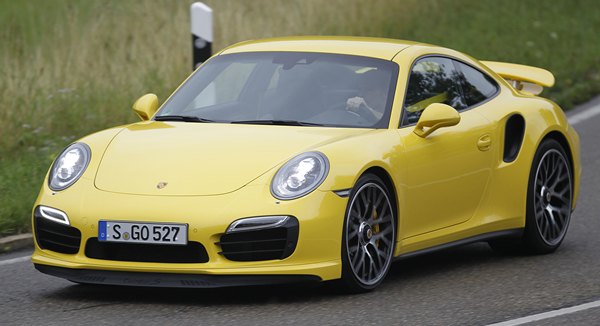 |
|
If
you want GT3 performance without sacrificing everyday comfort and
usability, you have to pick 911 Turbo...
|
|
All of the current
generation (991) 911s are good driver's cars. Because of this,
choosing among them could be a big headache. Traditionally, Carrera
is the entry level fun while Carrera S offers a little bit more speed
and thrills. The GT3, GT3 RS and GT2 are road and track machines
targeting at really hardcore drivers. If you want GT3 performance
without
sacrificing everyday comfort and usability, you have to pick 911 Turbo
and its slightly sportier version Turbo S. Benefited by the thick
torque curve of
turbocharging and all-weather traction of 4-wheel-drive system, they
should be the fastest 911s in the real world, at least in the hands of
ordinary drivers.
In the past few years, the unique position of 911 Turbo was seriously
threatened by Nissan GT-R, which was not only a lot cheaper to buy but
also faster to accelerate and better balanced. Comparatively, the
Porsche was more prone to pitch and dive, under/oversteer and traction
problems, all blamed to its rear-engine layout. While this inherent
disadvantage is not going to be rectified completely, the arrival of
991 chassis does help taming its handling a lot. A stretch of 100 mm
wheelbase improves its directional stability. The lighter and stiffer
aluminum-steel hybrid chassis combines with wider tracks and a lower
roof contribute to cornering stability. The sleeker body shell and a
higher setting tail improve aerodynamics – not that the 0.31 Cd is
altered, but aerodynamic lift is much reduced. Partly helped by a
pneumatic-operated lip spoiler that can extend in 3 stages and a rear
wing whose height and angle are both adjustable according to speed, the
car now generates 132 kg of downforce at 300 km/h (186 mph).
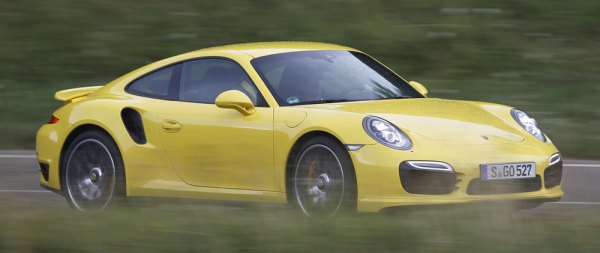 |
|
A
stretch of 100 mm wheelbase improves its directional stability.
|
|
As before, the Turbo runs wider rear wheel arches to distinguish from
naturally aspirated models. Each side is extended by a further 28 mm
from the already wide-track Carrera S, 4S or GT3. Another trademark
feature is the large air intake at each side, which is necessary to
cool the fire-breathing turbocharged engine. Up front, the nose gets
unique daytime running lights and intakes. At the back, the highlight
is the bigger, bi-plane rear wing, of course.
Inside, the cabin is basically the same as other 911 members. This
guarantees an excellent driving position, seat comfort, ergonomics and
instruments. The build quality is very good, as in the case of other
991s, so it feels far more expensive than the last generation.
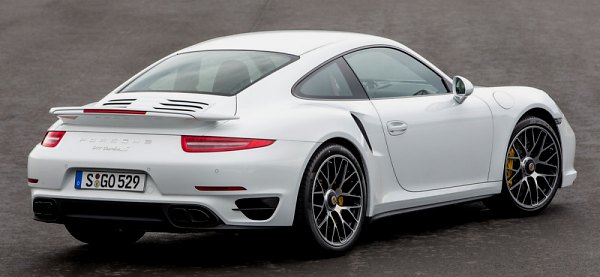 |
|
The
most significant new tech is rear-wheel steering...
|
|
Apart from the new chassis, a few other technologies should improve its
handling. The most significant of which is the
electronic-controlled rear-wheel steering system taken straight from
the GT3. It counter-steers in slow corners to cut understeer, and
steers in the same direction at higher speeds to aid stability. The
result is a balance closer to neutral than ever. Another is the updated
4-wheel drive system, whose Haldex multi-plate
clutch is now actuated by electrohydraulic instead of hydraulic,
enabling faster response and more effective rear-wheel torque
vectoring. Besides, the Turbo continues to feature goodies like PASM
adaptive damping. In case of the more expensive Turbo S, it is
additionally equipped with active engine mounts, PDCC active anti-roll
bars and PCCB ceramic brakes.
Less changed is the powertrain, which still consists of a 3.8-liter
direct-injected and twin-VTG-turbo flat-six and a 7-speed PDK gearbox
like the last 997 Turbo 3.8. It just differs in fine tuning. The
standard Turbo now produces 520 horsepower, barely 20 hp up from the
old car. Turbo S is boosted to 560 horsepower, 30 hp up. Considering
they are no lighter than their predecessors (in the case of Turbo S, it
even gains 20 kg), is the power boost too modest? McLaren's 3.8-liter
twin-turbo V8 is considerably more powerful at 625 hp, but Porsche's
flat-six is admittedly more torquey – the Turbo S pumps out 516 lbft on
1.2 bar or 553 lbft on momentary overboost to 1.4 bar, compared to the
McLaren's 442 lbft. This is exactly how it feels on the road. The
turbocharged boxer
motor is not very high-revving. It doesn't need to, because its
mid-range torque is really sensational. Unlike the case of GT3, you
tend to use the PDK gearshift less, keep it at a higher gear and let
the tremendous torque do the job! Porsche quotes 0-60 mph in merely 3
seconds flat for the Turbo S, which is incredible but highly
believable. 0-100 mph sprint should take 6.8 seconds. In other words,
it is in the league of MP4-12C and 458 Italia. The standard Turbo is
barely slower, and you will need to be sensitive to feel the
difference.
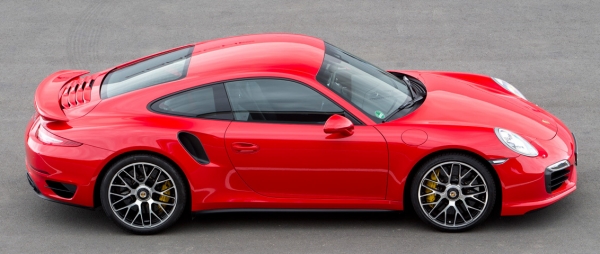 |
|
Straight
line performance is in the league of MP4-12C and 458 Italia.
|
|
Ultimately, can it beat our beloved GT3? Well, not if the drivers are
good and fully committed to driving. Porsche timed the Turbo S to lap
Nurburgring in 7 min 27 sec, 2 seconds behind the GT3. Admittedly, the
GT3 always come with stickier track-friendly rubbers. Equipped with
such tires, the Turbo S struck back in 7 min 24 sec. However, both
numbers fail to beat the best time of Nissan GT-R.
The driving experience is also much different from the GT3. Burdening
by the extra 175 kilograms, it doesn't feel as sharp and responsive to
steer. The electrical helm on this car is not as sensitive to road
surfaces, transmitting less tactile feel than the GT3's, or closer to
the Carrera S. The 4-wheel-drive model displays a little bit more
understeer all the time, although that is already reduced from the old
car. The turbo engine lacks the enthusiasm of the high-revving
naturally aspirated unit, losing the addictive sound and the amazing
throttle response. Gearshift of the PDK box is not as lightning quick,
too. All these are the inevitable tradeoffs of the increased torque,
weight and the switch to all-wheel-drive system. In pure driving terms,
the Turbo and Turbo S are not as involving to drive as the GT3, or to
lesser extent the Carrera S.
 |
|
In
pure driving terms, the Turbo is not as involving to drive as the GT3,
or to lesser extent the Carrera S.
|
|
Nevertheless, judging from the baseline of the last 997 Turbo, the 991
Turbo is a considerable progress. It maneuvers with less pitch and
roll, less understeer hence higher precision. Its 4WD system offers
more traction, allowing you to get back to throttle earlier and
accelerate quicker out of corner. The 4WS and PTM stability control
keep it on rails, killing any chance of big oversteer. You can carry
huge speed through corners without worrying that it bite you. This is
to say it is very well mannered. The ride quality is also good for a
car with supercar performance. GT-R aside, there are probably no other
production cars can cover ground with such speed and sense of security.
Unfortunately, the Turbo and Turbo S cost £120,000 and
£140,000, respectively. The former is 60 percent more expensive
than the GT-R, while the latter edges uncomfortably close to the level
of Ferrari 458 and McLaren MP4-12C. It might be a little better to
drive and a lot better to own than the mighty Nissan, but is it 60
percent better? I don't think so. On the other hand, it lacks the
driving thrills and sense of occasion of the more exclusive Ferrari and
McLaren. In the end, if we are to buy a 911, it has to be the new GT3,
especially when it has become so comfortable and usable now.
|
Verdict:     |
Published
on 2
Mar 2016
|
All rights reserved.
|
|
991 Turbo facelift 2016
|
|
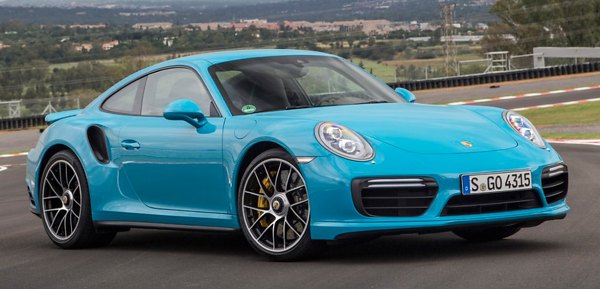
|
|
Small
changes, big differences.
|
|
It
is easy to underestimate the progress this car has made, because from
the spec. sheet you see no significant changes. The engine remains that
3.8-liter VTG twin-turbo boxer. Its output is lifted by merely 20
horsepower in both Turbo and Turbo S, whereas torque output is
unchanged. Likewise, the chassis seems to be untouched in the
conversion from 991 to 991.2. The old cars already got goodies like
4-wheel-drive, 4-wheel-steering, adaptive engine mounts, adaptive
dampers and active anti-roll bars. The new car adds nothing to the
list. Outside, there are only minimal changes made to its aero kits and
styling. The latter is not all that good, especially the retro-looking
vertical grilles on its engine cover. Maybe Porsche concentrated too
much resources to the recent update of Carrera thus have the Turbo
ignored.
But then you notice that the new Turbo S has its top speed raised by a
significant 8 mph to 205 mph. GT2 aside, this is the first road-going
911 breaking the magic 200 mph mark. The base Turbo is also very quick
at 199 mph. Both cars cut a couple of tenths from 0-60 mph sprint, more
than the small power boost could explain. Most telling is Nurburgring
lap time – the new Turbo S recorded a best of 7 min 18 sec, 9 seconds
clear of the old version. How can the scale of these improvements be
explained by the subtle technical changes?
Actually I suspect the Turbo S makes more than the claimed 580 hp.
Maybe even more than 600 horses. Compared with the last version, its
compressor turbines have been enlarged from 56 to 58 mm to realize 0.15
bar higher boost pressure. This is backed with modified intake ports,
fuel injection nozzles and higher fuel pressure. To compensate the
heavier turbines, Porsche introduces “dynamic boost” function, which
cuts fuel injection but keeps the throttle butterflies wide open when
the driver back off throttle briefly, thus keeps the turbines spinning
and minimizes turbo lag. In the real world, the new engine is
astonishingly powerful yet responsive. Don’t believe the official 0-60
mph time of 2.8 seconds! It is a conservative estimation. Expect 2.6
seconds or less is easily repeatable in the real world!
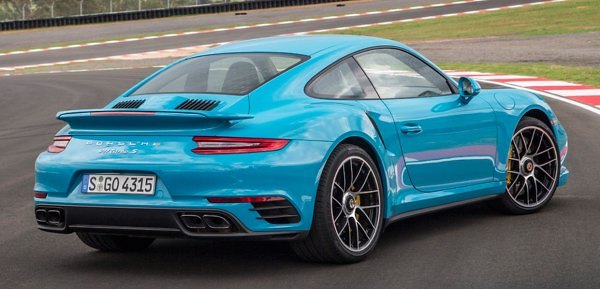
|
|
The
new engine is astonishingly powerful yet responsive.
|
|
It’s not only straight line speed, but nearly all areas of the 911
Turbo seem to be improved. The electric power steering, which used to
be a weak point of the old car, finally gains feedback that a Porsche
deserves after 3 years of evolution. The chassis, which used to display
too much initial understeer, gets more accurate in action. Not only the
understeer is reduced, you can balance with throttle more readily,
tucking the nose into line and even pushing the tail sideway if you
give it enough aggression. Thanks must go to the modified multi-plate
clutch in 4WD system, which employs clutch discs made of higher
friction materials to react faster. I suspect the further tuning of
active suspension and rear-wheel steering might play a part, too. After
all, the 911 Turbo has so many weapons to play with. It is only a
matter of time for Porsche to find out the optimized setting that it
failed to manage in the first occasion.
On the road, the sheer traction, grip and speed displayed by the new
911 Turbo is simply astonishing. Apart from McLaren 570S, 911 GT3 RS
and Nismo GT-R, I’m afraid nothing come close to its real-world speed.
Not even any Aston Martin, Audi R8 or the fastest AMG GT. When
all-weather security and day-to-day usability are taken into account,
it has to be the most obvious choice.
Brilliantly, its fuel consumption is also reduced by 6 percent. Some
contribution is made by the remapped engine and transmission controls,
some must thanks to the new dual-mass flywheel with centrifugal
pendulum, which reduces vibration and allows the PDK box to run at
lower revs on high gears.
If there is anything the 911 Turbo lacks, it is probably a sense of
occasion that only the low-volume McLaren managed to offer, or the
purist character that the naturally aspirated and rear-drive GT3 RS
possesses. It's not quite as agile or as engaging to drive as the GT3
RS, but as a superfast GT, it is hard to beat.
|
Verdict:      |
Published
on 16
Nov 2017
|
All rights reserved.
|
|
911 (991) GT2 RS
|
|

|
|
£208,000
for a 911? Porsche thinks it is worth, and it is back up with a new
Nurburgring lap record.
|
|
Speed.
By far the most important to 911 GT2 RS is definitely speed. Without
the
extraordinary speed, it is impossible to justify the car's
£208,000
starting price, which is nearly 3 times that of the cheapest 911 on
sale. In
other words, it is on a par with exotics like McLaren 720S and
Lamborghini Huracan Performante. It even makes the £183K Ferrari
488GTB
sounds like a bargain, especially when you factor in the optional
Weissach
package, which adds another £21,000 to the price tag for a weight
saving of 30 kilograms. In terms of straight line speed, the GT2 RS is
not quite at the same level as the McLaren, as it takes 8.3 seconds or
half a second more than its rival to sprint from 0-124 mph. However, it
runs neck and neck with the Ferrari and beats the naturally aspirated
Lamborghini convincingly. Its 211 mph top speed is way beyond the
Italians and just a single mph shy of the British exotic. Perhaps
most important to Porsche, the GT2 RS ran a 6:47.3 lap in
Nürburgring Nordschleife, taking the still-warm production car
record from Huracan Performante. Yes, it is a full 10-seconds faster
than
the 918 Spyder! How can a 911 beat the company's million-dollar hybrid
supercar? This is called Progress.
The GT2 is not a new label. In fact, it has been existing since 1995,
when
the 911 was still in the air-cooled era. The first 993 GT2 used a classic 3.6-liter
air-cooled motor with 2 valves each cylinder, twin-turbocharged to
produce 430 hp. The following 996
GT2 improved that to 462 hp as it switched to water-cooled and
modern 4 valves per cylinder. Both were a bit notorious for edgy
handling as they ditched 4WD hardware for less weight. The 997 GT2
in 2007 introduced VTG turbos and expansion induction to increase
output to 530
hp, but even better news was that its chassis finally got up to the
job, or nearly. Unfortunately, it lost the Nurburgring lap record to
Nissan
GT-R shortly afterwards. Therefore, in 2010 Porsche upgraded the GT2 to
GT2 RS. 620
horsepower, extreme weight saving and an eye-popping
price tag redefined the ultimate production 911. Its philosophy is carried
over
to the new 991 GT2 RS, although power and performance have been
lifted to a higher level again.
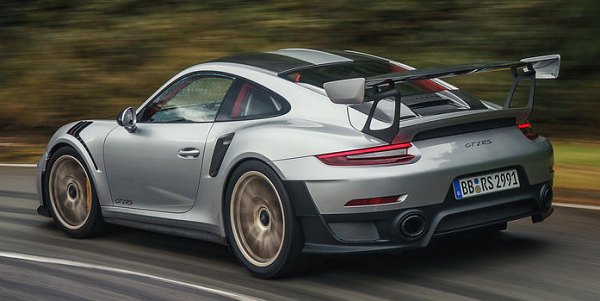
|
|
The
211 mph top speed is actually electronically limited to avoid
overkilling its Michelin Pilot Sport Cup 2 tires...
|
|
Basically, the new GT2 RS is a combination of the engine from 911 Turbo
S and the chassis from GT3 RS, with both modified for higher
performance, of course. The 3.8-liter twin-turbo engine is 200 c.c.
larger than that of the old car. It keeps the unique expansion
induction for denser intake air hence more power (see 997 GT2 for its principles).
Compared with the Turbo S motor, its variable-geometry turbochargers
get larger, increasing maximum boost pressure from 1.35 bar to 1.55
bar. Meanwhile, compression ratio is scaled back from 9.5:1 to 9.0:1 to
avoid overheating the cylinder heads. The air intakes, exhaust
manifolds and intercoolers are all enlarged. The titanium exhaust is
lighter and generates less back pressure. The pistons, crankcase and
main bearings are all strengthened to withstand its extra power.
Moreover, the intercooler gets water spray injection to help sustaining
high output, a technology Subaru has been using on its Impreza STi
since 1994 (not to be confused with the water injection tech of BMW M4
GTS, which injects water directly to the intake air and enters
combustion chambers). The outcome is a neat 700 horsepower released at
a neat 7000 rpm, 120 hp more than the Turbo S and 80 hp up from the
last GT2 RS. It can rev quite high to 7200 rpm – if no match for
Ferrari 488GTB’s 8000 rpm, and a far cry from the GT3’s magic 9000 rpm
– but the maximum torque of 553 lbft, obviously limited by the PDK
transmission, is available from 2500 to 4500 rpm. So it is both
powerful and tractable.
Despite losing 4-wheel drive, Porsche quotes 0-60 mph taking only 2.7
seconds, right there with its rivals. Incredibly, the 211 mph top speed
is actually electronically limited to avoid overkilling its Michelin
Pilot Sport Cup 2 tires. Its engineers predict that the true potential
is beyond 220 mph, a surprise to me considering its massive aero kits
return a Cd of 0.35.
The aerodynamic design is very close to GT3 RS, especially the louvered
vents on the front fenders and the massive carbon-fiber rear wing
mounted on aluminum brackets. However, the GT2 RS necessitates XL-size
air intakes at the nose and 2 additional NACA ducts on the front bonnet
to cool its radiators. At the rear, by moving the large exhausts
outboard, it frees up space in the middle for a more effective
diffuser. At its 211 mph top speed, it generates 340 kg of downforce.
This can be raised further to 450 kg if you manually adjust its rear
wing angle for track use.

|
|
Sraight
line performance is jaw-dropping. If there is any difference between it
and McLaren 720S or a Bugatti Chiron, it is undetectable by the driver.
|
|
Building on the 991-series chassis for the first time, the new GT2 RS
is larger, stiffer and more sophisticated than the old car, of course.
It has some features that the old car could not dream of, such as
4-wheel steering, adaptive engine mounts, active differential and PDK
gearbox, which inevitably increase weight. The chassis is part-aluminum
and part-steel as in all 991s, but the exterior panels are converted to
lighter materials as far as possible. The front fenders, front bonnet,
engine lid and rear wing are carbon-fiber. The roof is made of
magnesium as in the case of GT3 RS, but if you take the Weissach
package, it will be converted to carbon-fiber. The rear and rear side
windows are replaced with lightweight Gorilla glass, which is more
resistant to scratch than the old car’s polycarbonate (plastic) items
but weigh the same. Inside, most sound deadening materials are deleted.
The GT3 RS and 918 Spyder donate their small steering wheel, thin
carbon-shell bucket seats and fabric door pulls. Air-con and
infotainment system are retained, but the rear seat is replaced with a
steel half-rollcage to please trackday drivers. In case of Weissach
pack, this rollcage is converted to titanium, the anti-roll bars become
carbon-fiber items and the wheels are replaced with magnesium ones
which save a valuable unsprung weight of 11.5kg. Overall, the GT2 RS
with Weissach pack tips the scale at 1440 kg, 160 kg lighter than the
Turbo S. Nevertheless, it is still 70 kg heavier than the last, simpler
997 GT2 RS.
Unexpectedly, despite the massive power, it wears the same Cup 2 tires
as the (admittedly overtired) GT3 RS, with 265/35ZR20 front and
325/30ZR21 rear. Carbon-ceramic brakes are standard, of course. The
suspension is developed from the GT3 RS as well, but the tuning is
quite different: up front, the spring rate is increased by a massive
100 percent while anti-roll bar is softened by half; At the rear, the
springs are 30 percent stiffer while anti-roll bar is unchanged in
order to cope with the heavier engine. Helper springs are used so that
the main springs can be lighter. As it is a track car, camber, caster,
toe, ride height and anti-roll bars are all adjustable. However, the
most influential change is probably replacing all rubber bushings in
the suspension with rigid rose joints, eliminating slack and sharpening
response at the expense of NVH suppression. It is the first Porsche
road car to get this racing feature, not even the GT3 RS! Obviously,
this is the most serious ever road and track car coming out of
Weissach. How does it behave on the road?
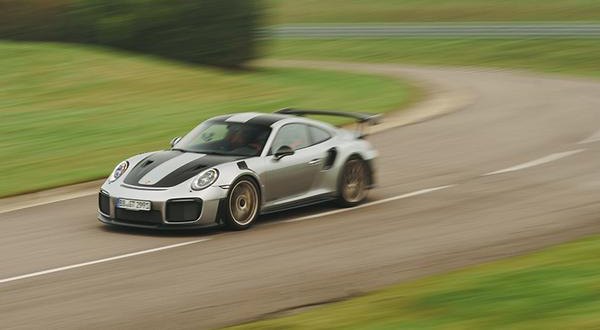
|
|
Even
compared with the high standards of GT3 RS, it has found improvement on
2 areas: steering and grip.
|
|
In daily commute, the GT2 RS is not as hardcore as imagined. Yes, the
rose-jointed suspension transmits more shocks and vibrations to your
seat of the pants, and the damping certainly feels firm rather than
supple, but it is still acceptable for keen drivers. The highly boosted
turbo motor has noticeable turbo lag under 2500 rpm, but don’t worry,
it is subtler than McLaren’s, and there is still good torque available
low down. The only problem is noise, and a hell lot of it. The
turbocharged motor is not the most musical in Porsche’s current lineup,
let alone the naturally aspirated 4.0 of GT3. Its exhaust note is much
deeper and bassier, but it is loud. From the point the power starts
surging to 4000 rpm, the exhaust note becomes boomy. The thinly
insulated cockpit becomes very noisy, so noisy that you need to shout
to have conversation with your passenger during a 70-mph cruise. Maybe
the GT2 is not so GT. It is a race car for the road.
However, this engine is still amazing. Once it gets into full steam, it
works seamlessly with the PDK box, the acceleration is so strong and
neverending. The engine revs cleanly to the 7200 rpm redline, unlike
some heavily boosted engines whose magic concentrated in the mid-range.
The angry roar, mixed with bangs and wastegate whooshes, is far more
exciting than that of the 911 Turbo S. The straight line performance is
jaw-dropping. If there is any difference between it and McLaren 720S or
a Bugatti Chiron, it is undetectable by the driver. In other words, it
has more performance than you would need on any roads.
More so than the old car, it has a good chassis to match its absurd
performance. Even compared with the high standards of GT3 RS, it has
found improvement on 2 areas: steering and grip. The steering is the
best yet electric power steering from Porsche, or perhaps anywhere. It
is perfectly weighted, accurate and delivers outstanding feel. The
light nose of the car follows your instructions keenly. Turn-in is
sharp but not nervous, thanks to the functioning of rear-wheel
steering. The grip and traction offered by those Cup 2 tires are
tremendous. Maybe the compounds or the suspension geometry are
different, it feels even grippier than the GT3 RS. Losing 4WD is never
a worry, at least on dry surfaces, even though the car has 700
horsepower going through the rear tires. In addition to the huge
downforce, you can push the car incredibly fast in bends on a racing
circuit. Now you understand why it can set the new Nurburgring record.
When you push the car too hard, it will run into understeer gently.
Lift off abruptly or give it another push mid-corner will kick its
heavy tail out, but it slides progressively so that never feels edgy.
The same cannot be said to any cars bearing the GT2 badge before. In
short, its handling is superb.
On back roads, the excellent handling remains. However, you will find
the current GT3 a better companion on road. The lighter car is a little
more agile. Its naturally aspirated motor is more responsive and more
engaging. Its suspension is more comfortable and the noise level is far
easier to bear. Moreover, while the GT2 RS needs you drive in angry
mode to load its suspension and aero to feel the best, the GT3 is more
communicative at half the pace. Unless you need that absurd speed, the
GT3 is the better all-rounder. Most important, it costs just half the
price of the GT2 RS.
|
Verdict:     |
|